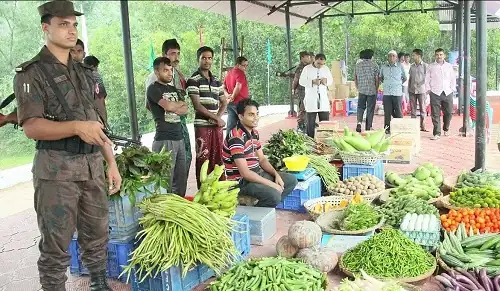Bangladesh-India Border Haats have been a positive story in the promotion of economic ties between India and Bangladesh. The markets have helped to simplify the process of cross-border trade, and have provided an important source of income for small-scale entrepreneurs and farmers. The success of the Haats has also had a positive impact on the wider economy and has helped to build mutual trust between the two nations. The expansion of the Haats would be a welcome development and would help to strengthen economic ties between the two countries even further.
Border Haats: A Brief History
In 2010, the prime ministers of Bangladesh and India signed a comprehensive framework agreement that included a memorandum of understanding (MOU) to promote cross-border trade and cooperation through the establishment of border haats, which are local markets facilitating small-volume trading among communities. As per the MOU, two haats were established in 2011-12 along Northeast India’s border with Bangladesh, located between Bangladesh’s Sunamganj and Kurigram districts and the Northeast Indian state of Meghalaya. In 2015, two more haats were established on the border between Bangladesh’s Brahmanbaria and Feni districts and the Northeast Indian state of Tripura. A revision of the MOU was made in April 2017 (an addendum had been signed in 2012) promising six more haats under the agreement.
The first Border Haat was established on July 23, 2011, and since then, the number of markets has grown to four
- Kalaichar (Meghalaya, India)–Baliamari (Kurigram, Bangladesh) ( established in 2011)
- Balat (Meghalaya, India)–Lauwaghar (Sunamganj, Bangladesh) ( established in 2011)
- Srinagar (Tripura, India)–East Madugram/Sagaria (Feni, Bangladesh) ( established in 2015)
- Kamalasagar (Tripura, India)–Tarapur (Kasba, Brahmanbaria, Bangladesh) (established in 2015)
The Border Haats are located on the zero line between India and Bangladesh. It permits citizens from neighboring areas to purchase goods from vendors of both countries in equal numbers, and all transactions are tax-free. The Haats are held once or twice a week. The market operates with both Indian and Bangladeshi currencies, but there is a limit on the amount of goods that buyers can purchase to ensure reasonable family consumption.
The traders are allowed to sell locally produced items such as fruits, vegetables, fish, and other agricultural products.
Amidst the Covid-19 pandemic, the operations of the border haats were suspended. However, they resumed at various intervals in due course.
Boosting Economic Ties
The Border Haats have not only helped to improve the livelihoods of people living in the border areas, but they have also played a crucial role in promoting trade and investment between the two countries. The Haats have helped to identify the demand for specific products on either side of the border, and this information has enabled traders to make informed decisions about what to sell and where. This has led to increased cross-border trade, which has had a positive impact on the economies of both countries.
Read also: BANGLADESH-INDIA TRADE RELATIONS, EXPLAINED
Simplifying the Process of Cross-Border Trade
Before the establishment of the Border Haats, cross-border trade between India and Bangladesh was often hampered by bureaucratic red tape and complex regulations. Traders had to obtain a number of documents and licenses before they could conduct business, and this often led to delays and corruption. The Haats have simplified the process of cross-border trade by eliminating the need for formal documentation. Traders can now buy and sell goods without any hassle, and this has helped to reduce transaction costs and increase the volume of trade.
Building Mutual Trust
The Border Haats have also played a crucial role in building mutual trust between the two nations. The markets have brought people from both sides of the border together and have helped to foster a sense of community. Traders have been able to establish personal relationships with their counterparts, and this has led to a greater understanding of each other’s cultures and ways of life.
Expanding the Scope of Bangladesh-India Border Haats
The success of the Border Haats has led to calls for their expansion. There is a need to establish more markets and widen the range of products that can be traded. This would require greater investment in infrastructure and logistics, such as the construction of warehouses, cold storage facilities, and better roads. The expansion of the Haats would also require greater cooperation between the governments of India and Bangladesh, particularly in areas such as visa regulations and customs procedures.








